An Indian Wedding
3 Comments
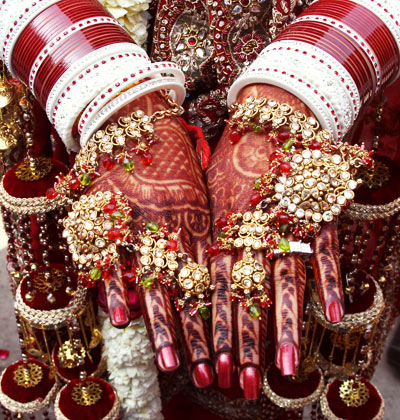
Jewelery worn by the bride on her wedding day. March, 2008. New Delhi, India.
By Adam Tait
Nearly midway through our stay in India, Tina and I had the good fortune to attend a reputably magnificent Indian wedding in the capitol, New Delhi. I have a good friend from school, Avlok Kohli, who heard we were headed to India and insisted that we attend his cousin’s wedding.
Both Tina and I are so deeply grateful that we did because it offered us a view of India that was both amazing and completely unlike anything we had seen so far, or expected to see.
For a traveller there are two completely different views of India; from the outside looking in and from the inside looking out. The extended family is the atomic institution upon which India is built, and once accepted as a family member, the world instantly lights up.
When we arrived in Delhi on a flight from Jaipur, we were warmly received by Avlok and his father. Avlok had been sent to another terminal by an official, but once we found each other in the crowd, I felt instantly relieved. Maybe it was a familiar face in an unfamiliar place, or simply a full english conversation, but either way it was welcome after being sick all through Rajasthan. Avlok’s father whisked us off to their flat in south Delhi, quite close to the hotel Puneet found us the first night.
The 3 day festivities were just about to begin at the Kohli residence, and you could hear that life was stirring from four floors down. We mounted the seemingly endless flights of stairs (Curious Note: Why do the Kohli families all have penthouse flats?) to a rush of Kohlis moving in every directions. Grandmothers sit and gossip in Avlok’s parents flat, while across the hall, Sonu’s mother yells at him to quickly get dressed. Today is Sonu’s wedding day, and as is traditional in India, the festivities are beginning later than planned (also referred to as “Indian Time”). Sonu is just getting out of the shower and we greet him wearing a towel, as he pops his head out of his room to return the marble shattering hindi reply to his mother. His voice becomes much softer and genuinely kind when Avlok introduces us. Before we have the chance to sit down and share a cup of chai, we are rushed off across town.
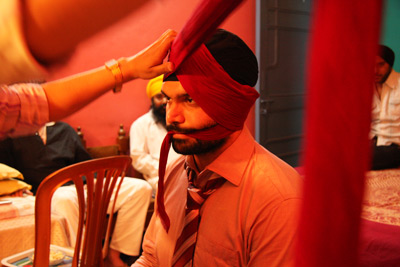
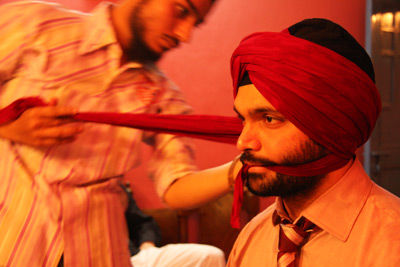
Sonu’s unmarried wife is a Sikh, and as part of the wedding ceremony, Sonu has agreed to appease her family by wearing a traditional Sikh turban. Sonu has a Sikh friend who has offered to wrap his ceremonial turban today, however he lives nearly an hour away. The streets of Delhi are wild and ever encroaching, surrounding the rolling car with crowds and cows. Tina hides her eyes as Sonu narrowly misses a rickshaw, then slams the brake pedal to the floor to halt inches from a fifty car traffic jam. My mind races trying to discern how Sonu knows which direction to turn. At the house, we are already late for the ceremony and dispense with the long formal introductions. Marching directly into the bedroom, we find the ten meter turban fabric being stretched and rolled. Sonu tightens his teeth on one end of the fabric while the other nine and a half meters fly around his head in a precise and artistic manner. The first wrap isn’t perfect enough for a wedding, so we get a second show. Finally, Sonu is ready. We wave to Sonu’s very talented friend and his family while the car speeds off towards the gurdwara (Sikh temple).
I am going to be honest, that I don’t fully understand all the proceeding and ceremonies involved in an Indian wedding. If you do, and you notice that I’ve made a factual error, please don’t hesitate to correct me. Hindus, Sikhs and Muslims all have unique traditions, although those of the Hindus and Sikhs are similar. We were in for a treat because Sonu’s (the groom’s) family is Hindu and Tashu’s (the bride) is Sikh. In order to represent the union of the two families, the wedding is also a union between the traditions of the two religions. The Hindu/Sikh wedding is a series of events staged to introduce the groom’s family to the bride’s, and bless both families.
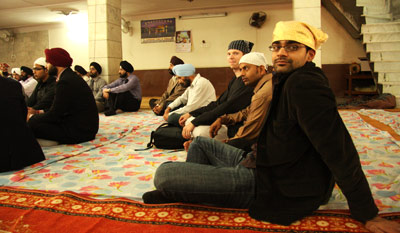
Adam and Avlock sitting on the male side of the gurdwara.
The first day held a ceremony at the bride’s gurdwara, where the groom was introduced to her family. The groom was force fed by the brides family, which I believe was a sign of respect. The ceremony was otherwise uneventful, but I was fascinated by my first experience in a gurdwara. The staff consists of the guru, and his band. The band plays a traditional indian chant, while the guru chants his blessings during the pauses. There was no idol that I could recognize, instead they had some ceremonial objects (including a knife) and a holy book, from which the guru would read. Men and women are separated in the gurdwara, separated by a colored fabric path from the entrance to the alter. Tina chose to disregard this obviously visible religious law, and sit with the photographers on the male (right) side.
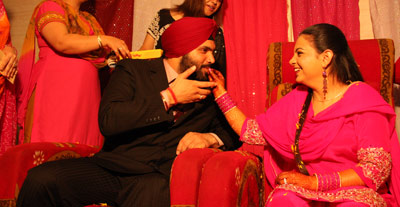
Ceremonial feeding of sweets during the engagement party on day one.
Following every ceremony is a banquet feast for all members of the wedding party. Since Indian families are enormous, they need a massive banquet hall to host the hundreds of people that constitute friends and family. Since the first two days are hosted by the bride’s family, they also plan the meals. Lunch on the first day is extravagant, but in hindsight, only modest compared with what was to come. Just before we sit down to eat, the bride and groom exchange rings that look cartoonish in size, with bright jewels encrusted. Sonu’s juvenile nephew, Nonu, wreaks havoc by tossing a fork into a crowd of elderly folks.
By the time we arrive back at the flat, Tina and I are both completely exhausted. Avlok reminds us that the day is only half over, and the real fun is only just beginning. “Tonight is henna night. A couple of henna artists will come over, and all the women on the groom’s side will be getting their hands and feet painted before dancing to Indian traditionally loud music. Last time, I got dragged into the middle of the dancing circle by Sonu’s mother, and was trapped for hours. Adam; you’re going to be their primary target.” I have never been very interested in dancing. This was enough to push me to dance on my own terms, by accepting to go salsa dancing at a club, instead. This was Tina’s first choice, since she’s a closet professional.
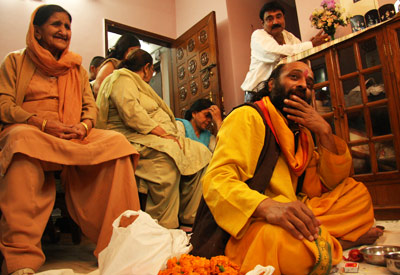
The ‘priest’ during blessing ceremony on the evening of day one.
We ordered Domino’s pizza and watched in wonder as Sonu was engaged in another ceremony. A man dressed in yellow and red appeared at the door, and was instantly welcomed and treated like a priest. This man sat Sonu down in the middle of the floor and proceeded to light cups on fire and put fruit into his hands. I quickly understood that the fruit was not for eating, but instead for blessing. The raggedly dress priest would repeat short chants, then utter instructions to Sonu. After requiring Sonu to bless various fruits and sweets, he painted Sonu’s hairy limbs with a yellow coloring. We take off just before the ceremonial shower to clean off the toxic yellow holy color.
I have painted a very sarcastic picture so far, but there are some heartwarming moments that I completely glazed over. As Tina would tell you, Indian hospitality is second to no other culture we have yet encountered. Even just knowing that I was a friend of a cousin’s, Puneet and his family went out of their way to help us in our first couple of very overwhelming days in India. When we arrived for the wedding, we were welcomed with open arms. The Kohli flats in south Delhi were completely over booked, with all beds accounted for, and unused floor space fought over. Where would we stay? Avlok’s neighbors were all too happy to take us in, offering us their bed, while they slept in their living room. Astounding. They even offered to help Tina put on her saree at 7 in morning. On our final night in Delhi, even though the Kohli’s had room for us, the neighbors still wanted us to stay with them, and so we did. Any time we stay with the greater Kohli family, food was always being pushed in front of us and anything we needed was instantly taken care of. Both Tina and I thoroughly enjoyed our stays with Avlok’s and Puneet’s families and are deeply grateful for their generosity.
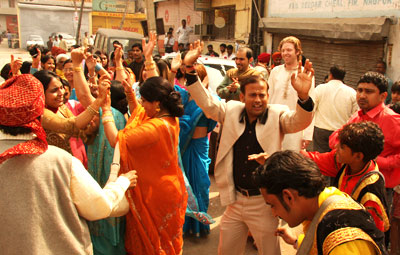
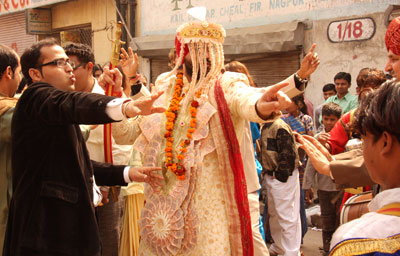
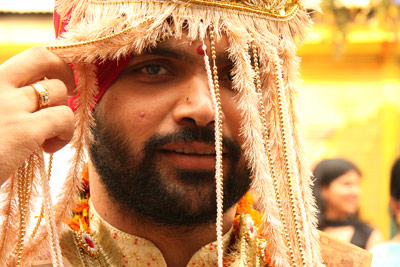
Dancing on the street, on our way to meeting the bride’s family.
The second day begins bright and early at 7 am. The events began with Sonu riding a very flashy horse to his local temple, symbolizing his journey to meet his bride. Sonu got fully suited, as a Rajput king should, and headed to the street to mount his horse for the long journey (5 minutes). The horse was fed, and the women (plus Avlok) danced to the band of drums and horns following Sonu’s lead. Once he reached the temple around the corner, we all jumped in cars and drove to the banquet hall. The groom’s family (including Tina and I) danced our way up to a well decorated arch blocked by the bride’s family. The band was so loud that they overpowered the industrial saws ripping through logs on the other side of the street. Upon meeting at the arch, the two families exchanged gifts (ten sets of blankets), and the bride’s family officially accepted Sonu. We were led into a new and even larger hall, where lunch and afternoon snacks were to be served. Sonu and Tashu were joined on an alter, where they were forced to sweat for more than half an hour while two video-camera-men with high voltage bulbs heated them with solar radiation. I felt most pity for Tashu, whose wedding day saree weighed more than 30 pounds.
Immediately after the photo session ended, we were back at the gurdwara for the official wedding ceremony. Ironically, this ceremony was attended by the least number of people, as most of the wedding party awaited Sonu and Tashu’s return to the banquet hall. The Sikh wedding ceremony is a simple one. There are four prayers which both the bride and groom chant, followed by a march around the alter. The Hindu equivalent is to circle a holy flame. At the end, the groom finally gets to hold hands with his new bride as they gracefully exit the gurdwara.
Tina and I make a quick exit as we were hoping to make it to Agra to witness the Taj Mahal over night. [See next post for details]
When we arrived back in Delhi, we were informed that the flat was infested with hijras, the night before. Tina was instantly fascinated by transgenders who wander into births, weddings and funerals because she yet to be approached by them. While in Jaipur waiting for Tina to buy a saree top, I found myself encircled by several imposing male figures dressed in female clothes and accompanied by two guys with drums. I was danced and kissed until the drummers could tell that I’d had enough, and moved on. Tina prodded and discovered that the hijras come to weddings to perform sexually suggestive dances and demand whatever sum they choose for they blessing and smooth exit. Last night, the hijras that came to the Kohli residence had left with more than ten thousand rupees, the equivalent of three hundred US dollars for twenty minutes of dancing. I was flabbergasted that anyone in India would actually respect these lower-class citizens enough to pay them whatever was demanded, reminding myself that no Indian respects anyone demanding money from outside their family. Just as we’re trying to understand another Indian inconsistency, another group of hijras shows up at the door. This group also happens to hail from the neighborhood and demand a fee, like it is their right. After some hostile negotiation, Sonu’s mother pays them to leave.
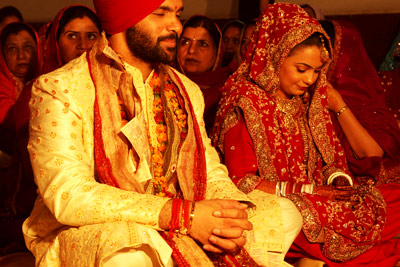
The final wedding reception is hosted by the groom’s family, and is held in one of the most exclusive five star resorts in Delhi. Avlok refers to it as a ‘five star location’. The party starts fashionably late at 9 pm, but is worth it. The food is a healthy feast, and both Tina and I marvel at the real vegetables, fresh stir-fry’s and pasta. Oh, and the Indian options were also spectacular. My meal is frequently interrupted by Puneet and his family trying to get Tina and I on the dance floor. I’m not certain he ate anything all night; he couldn’t stop dancing. The party cleared out quickly, as families with small children, of which there were many, left early. The final straw was when a fight broke out between Avlok’s father and a distant member of their family. The two of them were separated, but Avlok’s father was noticeably missing a few minutes later. We discovered that he disappeared, not because of the fight, but because Sonu chose to wear the ceremonial turban again. This evening was hosted by Sonu’s family, a Hindu family, and by wearing a Sikh turban, he was not showing his own family any respect. Avlok’s father disapproved and left. As I said at the beginning, the Indian family is a very closely-knit and proud institution. Families take each other, and their respect for each other seriously. The bad blood that night will be recycled, but will clear with time and effort. They are family, after all.
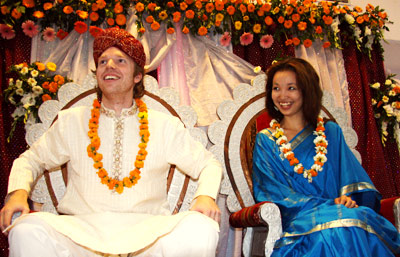
Day 2: at the ceremony.
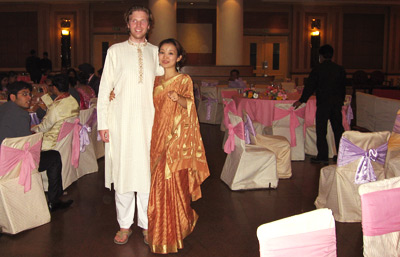
Day 3: at the reception.
- Browse in Timeline:
- « India Hates Me
- » Taj Mahal
3 Responses (2 Comments, 1 Trackbacks ):
Comments
Your Thoughts?
Add A Comment
We'd love to hear them! Please share:Trackbacks (1)
- Taj Mahal | Simply Tina » Taj Mahal - Dec 14 08


















tyler
Apr 21 08, 10:24 am
Chris Sharp
May 19 08, 5:34 am